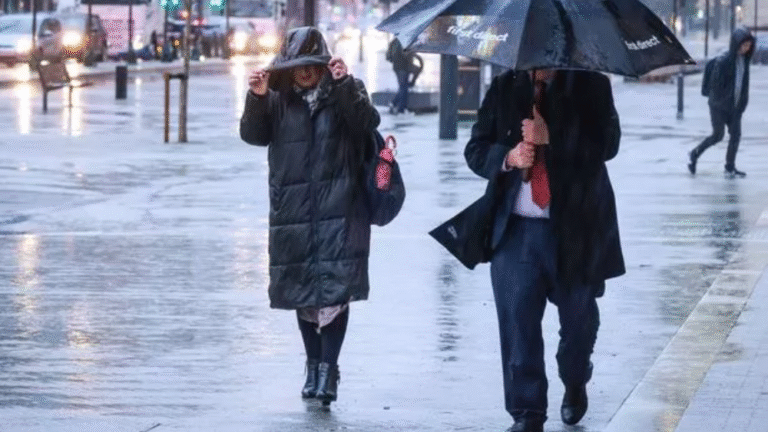The UK faces heavy rain and thunderstorms as the Easter weekend wraps up. Stay updated on weather alerts and travel disruptions across the country. Easter in the UK is often a mixed bag. Some years, we bask in mild sunshine with daffodils blooming and chocolate eggs melting under early spring rays. Other years well, we get what we got this time: grey skies, relentless downpours, and surprise rolls of thunder. If you were hoping to spend Easter Sunday in the garden, on the beach, or at a picnic in the park, this year’s weather likely had other plans for you.
As Easter weekend 2025 wrapped up, much of the UK found itself under umbrellas, waterproofs, or simply watching the rain streak down their windows from the comfort of home. Let’s take a look at how the weather unfolded, what caused the dramatic turn, and how the nation coped — or didn’t.
A Promising Start That Fizzled
The early forecast for Easter weekend showed some promise. Good Friday and even parts of Saturday offered patches of sunshine across the South East and Midlands, allowing many to sneak in an egg hunt or a walk in the countryside. Temperatures hovered between 11°C and 15°C — not quite “shorts and t-shirts” weather, but pleasant enough for spring jackets and coffee al fresco.
But by late Saturday evening, the skies began to change. A band of low pressure was creeping in from the Atlantic, dragging with it a cocktail of rain clouds, gusty winds, and unstable air. The result? A very soggy and noisy Easter Sunday.
Sunday Soaked: Rain, Thunder, and Power Cuts
For many parts of England, Wales, and southern Scotland, Easter Sunday began with heavy rainfall that didn’t let up. From Cornwall to Cumbria, rain lashed down in sheets, making roads slippery and walks almost impossible without getting soaked through. In some areas like South Wales and Devon, rainfall reached 40–50mm within 24 hours — more than what you’d expect for the entire week.
But the real surprise came in the form of thunderstorms. Usually more of a summer phenomenon in the UK, the presence of thundery conditions in early April caught many off guard. Rumbles of thunder echoed through towns like Birmingham, Bristol, and even as far north as Manchester. Social media lit up with videos of hail, dramatic lightning, and thunderclaps that startled pets and people alike.
In places like Surrey and Kent, storm cells moved through quickly but forcefully. There were reports of power outages, especially in rural areas, where trees toppled onto power lines due to saturated ground and gusty conditions.
Met Office Warnings and Travel Disruptions
The Met Office had issued yellow weather warnings for parts of the country starting on Sunday morning. These alerts covered potential flooding on low-lying roads, disruption to public transport, and localized power outages. And for once, the warnings came with near-perfect accuracy.
Across rail networks, delays were widespread. Water on tracks, speed restrictions due to strong winds, and signal failures meant Easter travelers faced extended journeys or were advised to stay home altogether.
On the roads, things weren’t much better. Motorways like the M25 and M6 experienced congestion not just because of bank holiday traffic — but because visibility and road spray made driving treacherous. Accidents were reported across several major routes, though thankfully most were minor.
Flood Alerts and Overflowing Rivers
Several flood alerts were put in place by the Environment Agency, especially for rivers in the Midlands and South West. The River Avon and parts of the River Severn saw rapid rises, leading to waterlogged fields and footpaths. Some riverside pubs and businesses — often counting on the Easter bump in trade — had to close or limit seating due to water encroachment.
Gardeners and farmers alike expressed concern, not over drought this time, but soil saturation. After a dry March, the sudden deluge was a shock to young crops and seedlings trying to establish roots.
How the Public Reacted: From Frustration to Cosy Acceptance
Let’s face it — Brits are no strangers to a rainy bank holiday. And while frustration was certainly evident (especially among parents of sugar-charged children stuck indoors), many leaned into the vibe.
Twitter and Instagram became flooded with posts of “cosy Easter vibes” — complete with steaming cups of tea, rain tapping on windowpanes, and Easter-themed films playing in the background. The classic British stoicism — or perhaps stubborn optimism — was out in full force.
Some quotes we spotted online:
“Well, there goes the Easter BBQ. On the plus side, my chocolate eggs didn’t melt.”
— @mumslife_uk
“Easter walk turned into Easter wade. Should’ve brought the kayak instead of the stroller.”
— @britdadventures
“Thunder, rain, and all the trimmings. It’s not Easter unless there’s a storm brewing.”
— @cloudykaren
Easter Monday: A Slightly Brighter Note
Thankfully, the rain began to clear by late Sunday night in many areas. While Easter Monday didn’t bring blazing sun, it did offer a break in the deluge. Cloudy skies and cool breezes remained, but families were able to salvage some outdoor time — albeit with wellies and coats still firmly in place.
Beaches in Brighton, Bournemouth, and parts of Norfolk saw a small uptick in visitors, especially among brave souls hoping to walk off the Easter feast. National Trust properties reported steady footfall, with guests choosing sheltered gardens and indoor tea rooms to avoid any leftover drizzle.
What Caused the Sudden Stormy Shift?
According to meteorologists, the culprit behind this chaotic weather was a clash of warm southern air with a colder Arctic front pushing in from the north-west. When this kind of atmospheric instability occurs, it often leads to convective activity — aka thunderstorms, heavy downpours, and short bursts of hail.
It’s not unheard of for the UK to experience this in early spring, but what made it dramatic this time was the speed and scale at which the storm system moved across the country. The added moisture from Atlantic winds only fueled the instability.
Looking Ahead: Will April Bring More Showers?
The age-old saying “April showers bring May flowers” seems to be holding up so far this year. Long-range forecasts from the Met Office suggest that April will continue to bring unsettled weather, with short-lived warm spells punctuated by cool, wet days.
That said, we may be in for more sunshine towards the end of the month, especially in southern England. Until then, waterproofs and sturdy boots are likely to remain a wardrobe staple.
Tips for Weathering the Spring Storms
If this Easter taught us anything, it’s that British weather is nothing if not unpredictable. Here are a few tips to help you stay dry and prepared for the rest of spring:
- Check Forecasts Regularly – The weather can change quickly. Apps like the Met Office or BBC Weather offer hour-by-hour updates.
- Always Have a ‘Plan B’ – Whether it’s an indoor activity for the kids or a backup travel route, don’t rely solely on sunshine.
- Pack Smart for Travel – If heading out for day trips or mini-breaks, include waterproof layers, spare socks, and umbrellas.
- Prepare Your Garden – Make sure drains are clear, and newly planted seeds are protected from heavy rain or flooding.
Easter 2025 may have ended on a stormy note, but it wasn’t without its silver linings. Families still came together, chocolate still got eaten, and the classic British resilience once again shone through the clouds.
For some, the rain added to the charm of the holiday — forcing a pause, encouraging rest, and making indoor moments feel just a little more special. And for others? Well, there’s always next year’s Easter weekend… and maybe, just maybe, a little sunshine.


